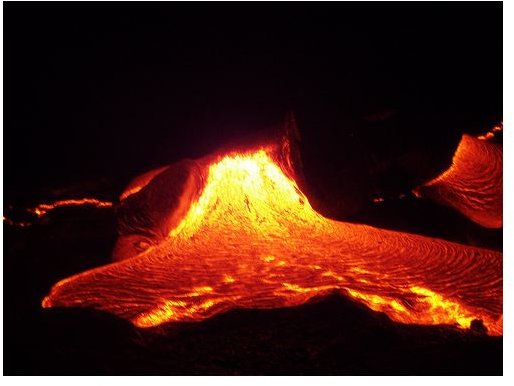Different Types of Lava and How Lava Moves
When a volcano erupts, it spews out molten rock, which is called lava. It is liquid in form and is extremely hot. The force of the blast and the viscosity of the liquid causes lava to flow away from the volcano. The composition of lava affects the way it flows, the speed at which it flows, and the resulting rocks that develop when the lava cools.
Image by Z2Amiller by Flickr
Basaltic Lava
Of the three different types of lava, basaltic lava is comprised of the least amount of silica. Generally, basaltic lava consists of 52 percent silica or silicon dioxide (SiO2). It has a high iron and magnesium content. It has a relatively low viscosity, when compared to other types of lava. It is the fastest flowing lava. Basaltic lava is commonly expelled from shield volcanoes, and it usually flows in the Pahoehoe or A’a style.
Andesitic Lava
The SiO2 content of andesitic lava is between 52 and 63 percent of its composition. It has a higher viscosity than basaltic lava and thus flows at a slower rate. Lava domes are commonly produced as andesitic lava is forced to the surface. Andesitic lava typically originates from stratovolcanoes and usually comprises a small volume that progresses no further than the volcano’s base. Its flow is described as block flow.
Rhyolitic Lava
Rhyolitic lava has the highest viscosity of any type of lava, and it has the greatest content of SiO2. Typically, the SiO2 content of rhyolitic lava is greater than 68 percent of its total composition. It flows much slower than andesitic and basaltic lava. Rhyolitic lava tends to ooze from erupting stratovolcanoes, usually after violent pyroclastic flows.
Pahoehoe Flow
The way lava flows can be described in terms of the size of the lava flow, the surface texture of the lava flow, and the structural makeup of the lava flow. If the lava features a continuous surface that is smooth, features ropy folds, and if the flow is thin in size, then it is described as a pahoehoe flow. The top surface of the lava folds onto each other as the lava beneath flows rapidly. This type of flow is associated with basaltic lava. The term ‘pahoehoe’ is Hawaiian for ‘smooth, unbroken lava’.
Sheet Flow
Sheet flow is another type of lava flow that produces a continuous surface. It is thicker than the pahoehoe flow, ranging between 30 and 100 feet in width. Sheet flows usually accompany explosive volcanic eruptions. The surface of sheet flows can range in texture from ropy to striated. A common feature among sheet flow lava is collapsed portions, which occur when the upper surface cools and hardens, while the lava beneath it empties out further down the flow.
A’a Flow
A’a flow is considered a discontinuous flow that features a fragmented surface that occasionally bursts. This type of lava flow commonly streams out of volcanoes rapidly. The term A’a is a Hawaiian word that means ‘stony rough lava’. This describes the appearance of the lava flow as it cools.
Block Flow
Another type of discontinuous lava flow is block flow. It is characterized by its slow movement, averaging three to 15 feet per day. As it cools, square blocks are usually left over. The rocks are smoother than those produced by A’a flows. Usually, block flows consist of andesitic lava.
Igneous Rocks

Igneous rocks are formed from lava as it cools. Different types of lava produce different types of igneous rocks. Obsidian is a type of igneous rock that lacks crystals and features a smooth, glass like black surface. Diorite consists of white and black coarse grains, while basalt is a fine grained, darkly colored igneous rock. Pumice is a porous igneous rock that is highly pitted. The holes and crevices in pumice are caused by the presence of gases in the lava as it cooled.
Image by Kevin Walsh from Flickr
From Lava to Igneous Rocks
The three different types of lava differ in composition and flow rate. Rhyolitic lava is the slowest moving type of lava, since it has a high viscosity due to a high silica concentration. Basaltic lava is the fastest moving lava because of its low viscosity resulting from a low silica content. Lava flow can be continuous, such as pahoehoe and sheet flow, or it can be discontinuous, such as A’a and block flow. As lava cools, igneous rocks are formed.
Reference
1. https://www.uwsp.edu/geo/faculty/ozsvath/lectures/lava%20types.htm
2. https://www.geology.sdsu.edu/how_volcanoes_work/andesiterhyolite_lava.html
3. https://library.thinkquest.org/17457/volcanoes/hazards.lavaflow.php
4. https://www.pmel.noaa.gov/vents/nemo/explorer/concepts/sheetflow.html
